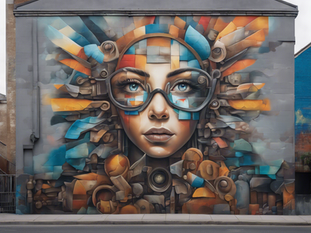
Ars. Latin: practical skill, craft.
Techne. Latin: skill, craft, or method of working, making, or doing. Via Greek, τέχνη = art, skill, cunning of hand. From Proto Indo European root √ teks = to weave (cf. textile).
In modern English we think of the artist as a genius individual who has unusual creative powers, and a technologist as one who is able to get machines to do things for us.
This usage reveals some underlying assumptions which lead us from an integrated and humane worldview to one of fragmentation and separation: a world in which a human is a mere robot subservient to machines in a world which itself is a nothing but a blind mechanism.

The traditional crafts were informed by a more integral worldview; one in which the human is a kind of bridge between the divine and earthly realms. He takes inspiration from an inner force which, in a certain sense, we might call otherworldly, and from that inner call acts in the world through his intelligence, intuition, and skill to divinise the material realm.
This inner force was the Muse. From where we get the verb, ‘to muse,’ as well as the music - from Greek my silos = something of or related to the Muse.
Tradition also has it that, rather than being a genius, one has a genius. The very word tells us this is so: from the root gen (gene, generate, etc), to be born, a genius was an inborn tutelary deity.
Both these terms imply a creative force which is at once inner and individual, and at the same time transcendent of one’s self. Rather than the heroic self-expression of the modern artist, the traditional artist strives to have something expressed through him, in an act of egoless surrender to a greater good.
This state of receptivity to the intuition (literally, ‘taught from within’) or inspiration (the ‘spirit within’) leads to an ecstasy of enthusiasm (‘the divine within) in the act of making itself, regardless of any final product or outcome. It is a state of flow where the individual, atomised self dissolves into a selfless state of connection with all things.

Thus the traditional crafts unite practical skill (hands) with the intelligence (head) and inner vision (heart). The overarching fields of study that lead to this integral approach are the quadrivium: the four fields of higher study which formed the basis of the original liberal education, so-called because they liberate the human from a merely mundane life into a divinised one.
The quadrivium (Latin: ‘four paths’) consists of arithmetic, geometry, musical harmony, and cosmology. All four are, at their root, the study of harmony, proportion, and inter-relatedness. Where modern education tends to fragmentation and separation (and leads to a worldview where nothing relates to anything else in any meaningful way), the classical quadrivium tends to integration, inter-relation, harmony, and to the three Platonic ideals of Truth, Beauty, and Goodness.

How does it do this? By explicitly relating each field through the common threads of number, harmony and proportion. Arithmetic is the study of number and proportion itself. Geometry is the study of number and proportion in space. Musical harmony is the study of number and proportion in time. And cosmology the study of number and proportion in space and time.
It is held by some of the greatest minds of the western tradition - from Plato to Pythagoras, Plotinus to Leonardo - that these fields of study are fundamental not only to the full flourishing of artisanship, but also to the full flourishing of the human heart. Plato claimed that this is so because the nature of the human soul itself is harmonious: by dedicating oneself to the study of external harmony, one may more readily perceive it inwardly and, finally, to recognise that the ‘inner’ and the ‘outer’ do not in fact exist except as an idea. We are ourselves harmonic beings, intimately and inextricably connected to the meta-harmonic being called the universe. We are nodes on one vast web of. Drops in one great ocean. Cells in one vast organism.

The traditional artisan, then, makes no distinction between art and technology. Neither between envisioning, designing, and creating an object. He is at once artist, designer, dreamer, magician, and maker. He is a chemist, alchemist, philosopher, and sage. For his occupation, that which occupies him, is the constant search for, connection with, and expression of Truth (literally ‘non-forgetfulness’ in the origanal Greek), Beauty and Goodness.

Finding himself joined, at all times and in all ways to all that exists, he is at home in the universe. He is the universe. And the works ‘he’ creates are simply the universe expressing and enjoying its own wondrous Self.



